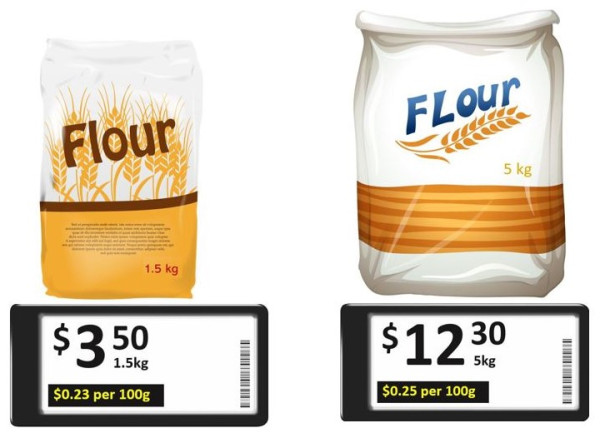How do you know you're paying the best price when you're shopping at the supermarket? Unit pricing makes it easy to compare prices on the same item in different sizes and packaging.
How can a unit price save you money?
There are many ways that supermarkets promote products. Discounts for bulk, packaged versus loose, and club card deals. Working out which is the best deal is confusing and sometimes impossible. By showing a 'unit price' alongside the total price, you can easily see which is cheapest by volume.
How does unit pricing work?
The Fair Trading Act requires that many items available in grocery stores must display a price per unit alongside the total price. The types of products, the standard measure for each product, and a minimum display size have been set.
This means that all supermarkets display the unit price in the same way so you can compare by product, brand or store. Grocery retailers must display the unit price for goods clearly and legibly, at no less than 25% the size of the marked price.
For example, you'll be able to compare a bag of potatoes with loose potatoes to see which is cheapest by 100 grams or, if a home-brand bottle of milk is cheaper ‘per litre’ than the national brand you usually buy.
Products ‘on sale’ or ‘club/member deals’ must display a unit price. In the below examples, the unit prices are highlighted in yellow in the price tags.
Multi-pack verses single item pricing
You can compare the unit prices of multi-pack offers with single items to check that the multi-pack really is better value.
Comparing value when buying in bulk
Buying in bulk can save you money. But not always. Compare unit prices to check which size is better value. In this example, the 1.5kg bag of flour is better value than the 5kg bag at 23 cents per 100g.
Purchasing pre-packaged or loose items
Fruit and vegetables can sometimes be better value when they aren’t pre-packaged. Checking the unit price will help to make sure you’re getting the best deal.
Are there exceptions for unit pricing?
Not all products sold at supermarkets must display unit prices. Alcohol, hardware items, flowers and meals and snacks prepared in-store are not included. Neither are products sold as single items such as a toothbrush or lightbulb.
Not every grocery retailer must display a unit price. The regulations only apply to physical retailers with an internal floor space of over 1,000 sqm and online retailers who sell all the following products:
- bread
- dairy products
- eggs or egg products
- fruit
- vegetables
- meat
- fish
- rice
- sugar
- manufacturer-packaged food
You can find detailed information on unit pricing regulations at the Commerce Commission.
When things go wrong
Any claims made about price must be clear, accurate and easy to understand for you as the consumer.
If you have a concern about the conduct of a grocery retailer or other business, you can complain to the Commerce Commission.
Contact us(external link) — Commerce Commission
